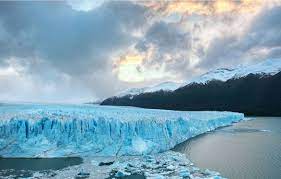The Patagonia Glacier is one of some of the fastest-melting ice sheets on Earth. As these glaciers disappeared, the Earth's layers beneath them rose up much faster than expected.
Patagonia is a geographical area that comprises the southernmost part of South America. This region is located in Argentina and Chile.
In the latest study, scientists discovered fissures in tectonic plates that began to form about 18 million years ago beneath a now-shrinking ice field. This fissure may have driven the uplift of rocks recently seen in Patagonia.
"The variation in the size of the glaciers, as they grow and shrink, combined with the mantle structure we described in this study, is driving the rapid increase and spatial variables in this region," said geophysicist Hannah Mark of the Woods Hole Oceanographic Institution who led the research. Alert, Thursday (3/3/2022).
When glaciers melt, the layers of Earth that were once beneath them bounce off and rise, no longer being weighed down by miles of ice.
This increase, called glacial isostatic adjustment, usually occurs over thousands of years, rather than decades, as was the case in Patagonia. As meltwater gushes from glaciers, it affects how much global sea levels will rise under the future climate warming scenario scientists are modeling.
Rapid uplift of the Earth's crust of more than 4 cm per year has been recorded in the ice sheets of northern and southern Patagonia. The layer in the region is now thinning and is only a fraction of its previous size.
The rise of the rock layers beneath which is roughly toe-length may sound trivial. But according to scientists, this is an extreme, unusual and sudden change on a continental scale. This change is also noted to be the largest glacial adjustment ever recorded to date.
In their study, Mark and colleagues recorded seismic data around the Patagonia ice fields surrounding the Andes Mountains in southern Chile and Argentina, to map what was happening beneath the surface.
Data collection went 10 months longer than planned, as seismic instruments got stuck in Patagonia during the first year of the COVID-19 pandemic.
Those measurements, combined with other seismic data from local monitoring stations, reveal how fissures in the tectonic plate descending nearly 100 kilometers beneath Patagonia have allowed hotter, less viscous mantle material to flow beneath the continent.
If the researchers' estimates are correct, the lower-than-usual viscosity in the mantle beneath this Patagonia ice field could accelerate the continental uplift associated with melting ice by decades or centuries.
"Low viscosity means that the mantle responds to deglaciation on time scales of decades, not thousands of years, as we observed in Canada for example," said seismologist Douglas Wiens of Washington University in St. Louis.
"This explains why the GPS measured the large uplift due to the loss of ice mass (in Patagonia)," he said.
Around and within the tectonic opening, University of Washington seismologist Douglas Weins, Mark, and colleagues also detected very slow seismic velocities, about 8% slower than the global average.
This anomaly suggests warmer mantle temperatures may be thermally eroding the overlying lithosphere that is thinning beneath the shrinking ice fields.
Shallow, slow mantle velocity and thinning crust have been detected beneath parts of Antarctica previously. Although previous research predicted that Patagonia's uplift would peak around the current rate, estimates of mantle velocity are uncertain and sensitive to mantle temperature. Thus, the more measurements the better.
What's more, the study found that the hottest and least viscous part of the mantle is near the fissure, or slab window, beneath the part of the Patagonia ice field that just opened.
"This suggests to us that perhaps the mantle dynamics associated with plate fissures have improved over time, or that continental plates to the south are starting to be thicker and colder, and thus less affected by plate fissures than parts of the plate further down. north," Mark explained.
As remote as Patagonia, the consequences of these glacial and tectonic changes will be felt globally. This is because rapidly melting glaciers are contributing to global sea level rise that has threatened low-lying communities.
A better understanding of this shifting land mass could improve predictions of sea level rise. In addition, what scientists learn about glaciers in one part of the world can help study ice masses in another.
"Understanding the evolution of these glaciers helps us understand what glaciers in Greenland and Antarctica might look like in the future in much warmer climates," said glaciologist Eric Rignot at NASA's Jet Propulsion Laboratory.
"With a better model of the Earth, we can do a better job of reconstructing recent changes in the (Patagonia) ice sheet," added Wiens.

